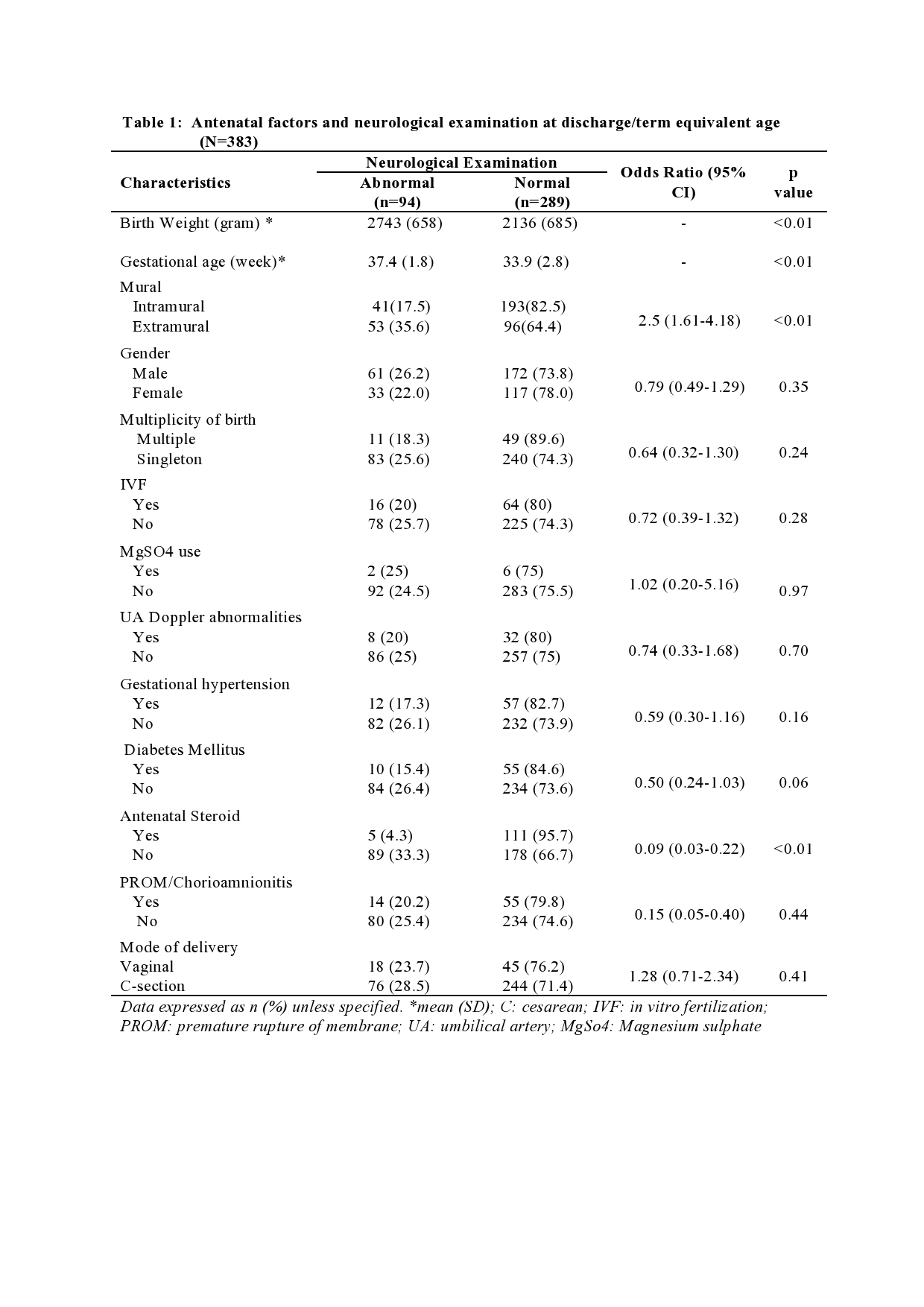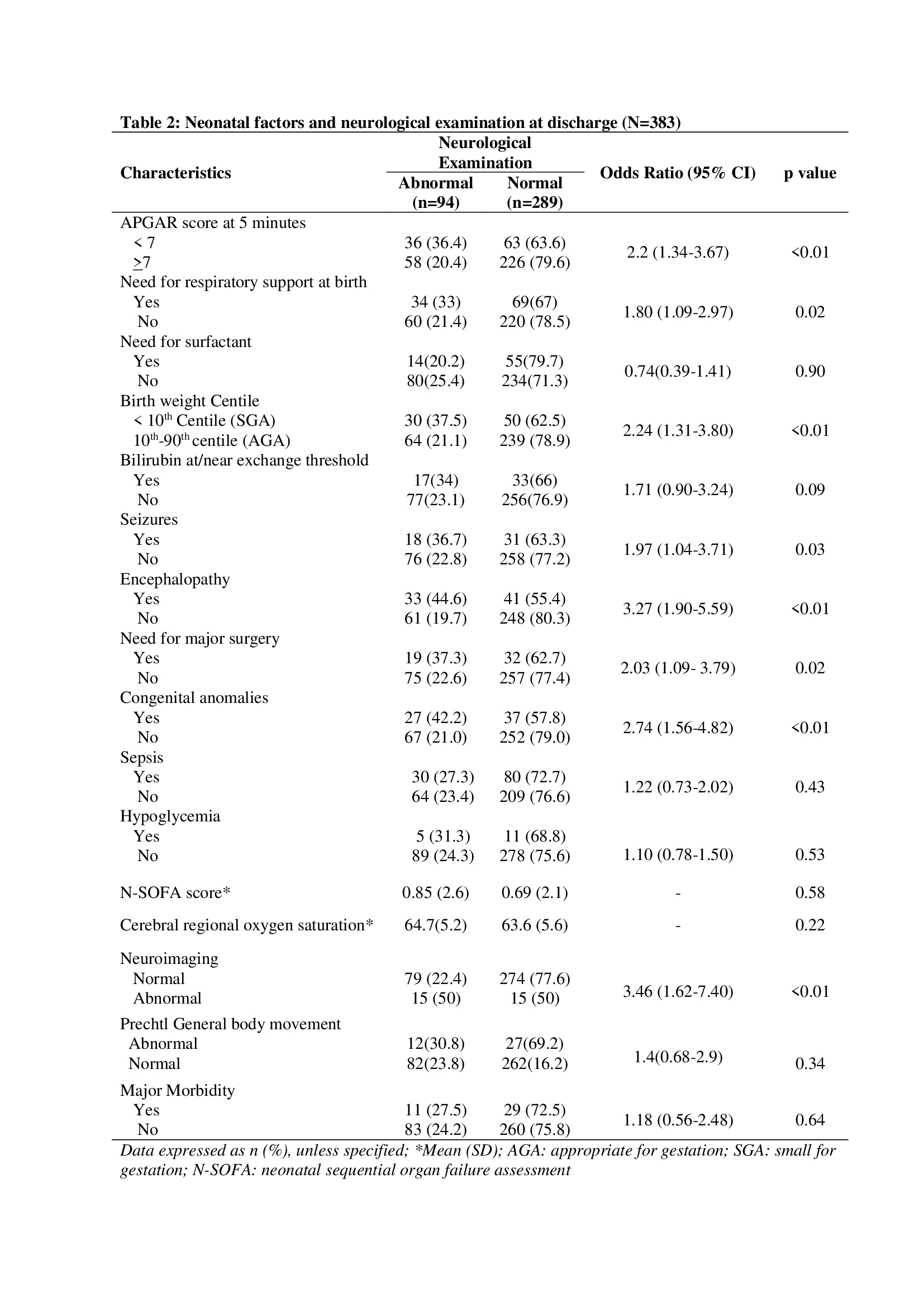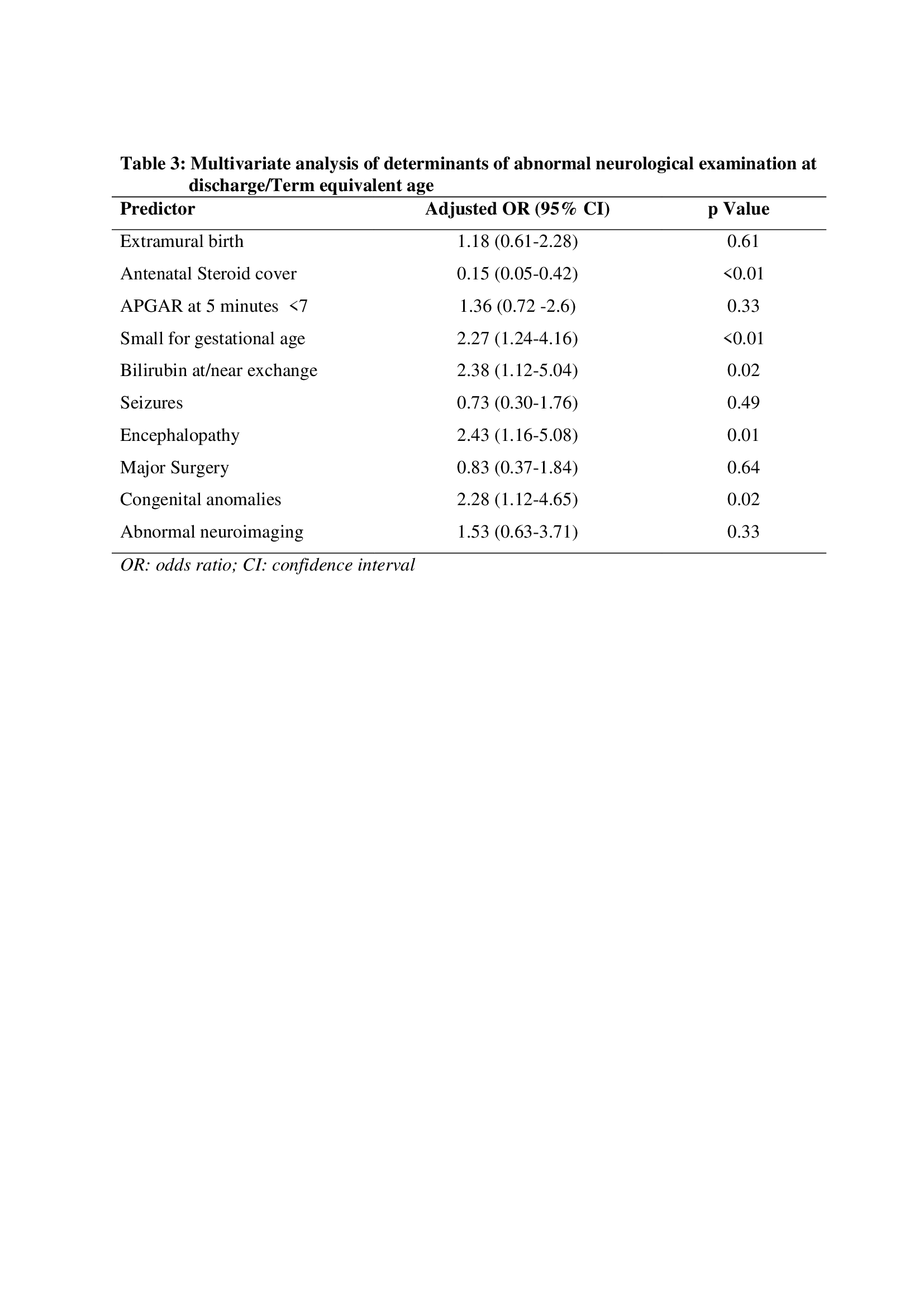Back
Background: Early identification and developmentally supportive care in the neonates at risk of neurodevelopmental impairments might improve long-term outcomes in this population. There is paucity of data regarding determinants of adverse neurological outcome among high risk neonates.
Objective: To evaluate the determinants of abnormal neurological examination at discharge/term equivalent age among high-risk neonates admitted to NICU.
Design/Methods: All high-risk neonates admitted to NICU were enrolled over a period of 15 months. Neonates were cared as per standard guidelines and relevant demographic, antenatal and neonatal characteristics were recorded. Neurological examination was performed at discharge/term equivalent age as per Hammersmith neonatal neurological examination (HNNE) and optimality scores were computed. An optimality score of < 26 in preterm and < 30 in term neonates was considered as suboptimal. Association of perinatal and postnatal factors with abnormal HNNE at discharge was evaluated using univariate analysis. Factors found significant on univariate analysis were evaluated using multiple logistic regression model to identify independent risk factors for abnormal HNNE.
Results: Of the total 451 eligible neonates, 53 were excluded and 398 neonates were enrolled. Of these, 15 neonates could not be assessed. Remaining 383 neonates were assessed and analyzed. Abnormal neurological examination was observed in 94 of 383 neonates (24.5%). On univariate analysis, extramural births, no/incomplete course of antenatal steroids, APGAR score of < 7, need for respiratory support at birth, small for gestational age, presence of encephalopathy, neonatal seizures, need for major surgery, presence of congenital anomalies and abnormal neuroimaging were associated with abnormal HNNE at discharge/term equivalent age (p< 0.05). On multivariate analysis, no/incomplete course of antenatal steroids, small for gestational age, hyperbilirubinemia at/near exchange threshold, encephalopathy and presence of congenital anomalies emerged as independent risk factors for abnormal HNNE at discharge/term equivalent age
Conclusion(s): Among high-risk infants admitted to NICU, no/incomplete course of antenatal steroids, small for gestational age status at birth, jaundice with bilirubin levels at or near exchange threshold, encephalopathy and congenital malformations were observed to be independent risk factors for abnormal Hammersmith neonatal neurological examination at discharge/term equivalent age



Neonatal Follow-up
NICU Follow Up and Neurodevelopment 5: Impact of Parents and Social Determinants of Health
160 - Determinants of Neurological Outcome At Discharge Or Term Equivalent Age In High Risk Neonates
Sunday, April 30, 2023
3:30 PM – 6:00 PM ET
Poster Number: 160
Publication Number: 160.363
Publication Number: 160.363
MUDITA ARORA, Sir Ganga Ram Hospital, New delhi, New delhi, Delhi, India; Satish Saluja, Sir Ganga Ram Hospital, New Delhi, India, NEW DELHI, Delhi, India; Manoj Modi, Sir Ganga Ram Hospital, New Delhi, Delhi, India; Arun Soni, Sir Ganga Ram Hospital, New Delhi, Delhi, India; Neelam Kler, Sir Ganga Ram Hospital, New Delhi, New Delhi, Delhi, India; Anup Thakur, Sir Ganga Ram Hospital, New Delhi, New Delhi, Delhi, India; Pankaj Garg, SIR GANGA RAM HOSPITAL, NEW DELHI, DELHI, Delhi, India

MUDITA ARORA, MD DNB Pediatrics (she/her/hers)
DrNB neonatology
Sir Ganga Ram Hospital, New delhi
New delhi, Delhi, India
Presenting Author(s)
Background: Early identification and developmentally supportive care in the neonates at risk of neurodevelopmental impairments might improve long-term outcomes in this population. There is paucity of data regarding determinants of adverse neurological outcome among high risk neonates.
Objective: To evaluate the determinants of abnormal neurological examination at discharge/term equivalent age among high-risk neonates admitted to NICU.
Design/Methods: All high-risk neonates admitted to NICU were enrolled over a period of 15 months. Neonates were cared as per standard guidelines and relevant demographic, antenatal and neonatal characteristics were recorded. Neurological examination was performed at discharge/term equivalent age as per Hammersmith neonatal neurological examination (HNNE) and optimality scores were computed. An optimality score of < 26 in preterm and < 30 in term neonates was considered as suboptimal. Association of perinatal and postnatal factors with abnormal HNNE at discharge was evaluated using univariate analysis. Factors found significant on univariate analysis were evaluated using multiple logistic regression model to identify independent risk factors for abnormal HNNE.
Results: Of the total 451 eligible neonates, 53 were excluded and 398 neonates were enrolled. Of these, 15 neonates could not be assessed. Remaining 383 neonates were assessed and analyzed. Abnormal neurological examination was observed in 94 of 383 neonates (24.5%). On univariate analysis, extramural births, no/incomplete course of antenatal steroids, APGAR score of < 7, need for respiratory support at birth, small for gestational age, presence of encephalopathy, neonatal seizures, need for major surgery, presence of congenital anomalies and abnormal neuroimaging were associated with abnormal HNNE at discharge/term equivalent age (p< 0.05). On multivariate analysis, no/incomplete course of antenatal steroids, small for gestational age, hyperbilirubinemia at/near exchange threshold, encephalopathy and presence of congenital anomalies emerged as independent risk factors for abnormal HNNE at discharge/term equivalent age
Conclusion(s): Among high-risk infants admitted to NICU, no/incomplete course of antenatal steroids, small for gestational age status at birth, jaundice with bilirubin levels at or near exchange threshold, encephalopathy and congenital malformations were observed to be independent risk factors for abnormal Hammersmith neonatal neurological examination at discharge/term equivalent age



